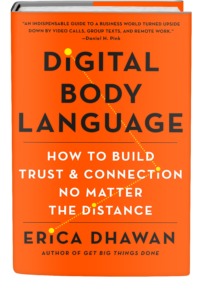The greatest leadership lessons I’ve learned have occurred on the dance floor. Dancing is an experiential form of being, learning, and doing. Moving your muscles helps you understand things in totally new ways.
I’ve danced my whole life. I’m a Bollywood dancer, but I'm also a globally recognized leadership expert, and I use movement in all my work. Through movement, I believe we can inspire creativity, deep listening, and cross-generational learning.
Why movement? Our minds and bodies are intrinsically linked; movement acts as a messenger between the two. When we can understand our own and others’ movements, our capacity to collaborate and harness our intuition skyrockets. And growing research in many disciplines–from neuroscience to sports medicine, from psychology to anthropology–supports these ideas.
Here’s what I’ve learned from all those years of hip shaking and shimmying:
1. Partnership
Dance teaches us about the push and pull of partnership, intellectually, viscerally, and kinetically. Dance partners learn how to work together, move together, listen to each other, and to move past missteps. Dance teaches trust. As innovators, we do the same. Our collaboration in teams and groups allows us to open up new ways of working with others, sometimes taking the lead and sometimes following. Regardless of who’s leading, we’re always in partnership with a larger movement or organization.
2. Adaptability
Harvard leadership expert Ron Heifetz uses the metaphor of dance throughout his renowned book on The Practice of Adaptive Leadership. When we adapt as innovators or move as dancers, we test new variations of working. This adaptability brings together the physical, emotional, and intellectual that all feeds our work as innovators. Learning new steps and combination in a dance is a challenge in a controlled setting and freedom within safety. Just learning a new dance move helps develop neuro-pathways and makes us more adept at solving problems in any area of our life. By giving yourself challenges in movement, you rewire your brain and have greater capability in your work.
3. Variation
In dance and in innovation, we often focus on a "final event." Learning variation allows innovators to practice the process of discovery in their work lives. Twyla Tharp, choreographer and author of The Creative Habit: Learn It and Use It For Life, asked her dancers to reverse their moves as if they were a mirror of themselves. This small variation created a whole new dance form called inverse variation. Similarly, an innovative leader can quickly test new variations of working and then decide which works best rather than talking on and on ad nauseum.
4. Inquiry
The questions we ask ourselves as dancers are questions we should ask ourselves as innovators. Think of your work as a piece of art you create. What is the rehearsal process? What does hardship look like? How is it structured? What’s holding the piece together? What judgments are you coming up with? How do you sustain yourself?
5. Audience
Building an audience as an innovator or dancer is about who you can connect with. Most people attend a performance because they’ve been encouraged to or they see that it relates to their interests. Ask yourself: What conditions do I want to build for success? Much of it is about sharing your ideas early on with others and embracing them, like you would in a first dance performance. Additionally, as in dance, the most important part of business innovation is the process of surfacing the knowledge in the room to use it in a different way. Innovators are given permission to see, comment, or fix. However, so much of innovating is observing and noticing and getting more voices in the room.
This post first appeared at Fast Company.

Speak Your Mind